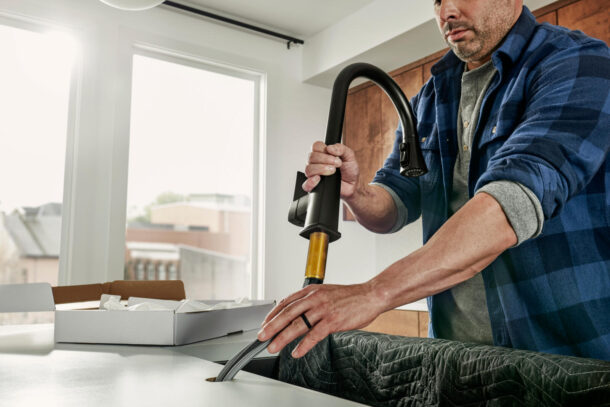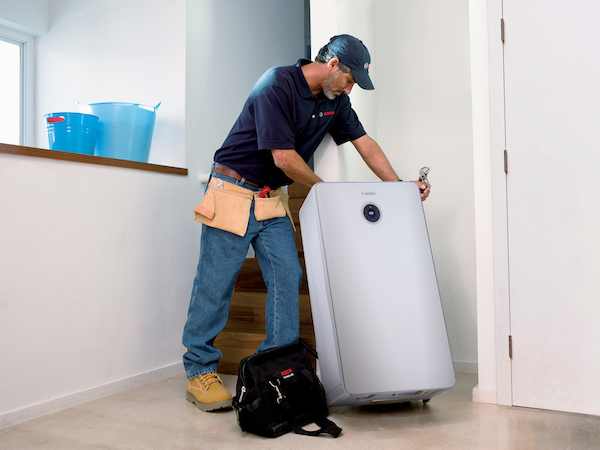Running a plumbing business would be much simpler if you could handle only one bathroom at a time, but it does not always work that way. At times, you will need to manage the work for multiple bathrooms at the same time, often requiring travel to different locations. Multi-bathroom projects can be a way to Read more
materials

Running a plumbing business would be much simpler if you could handle only one bathroom at a time, but it does not always work that way. At times, you will need to manage the work for multiple bathrooms at the same time, often requiring travel to different locations. Multi-bathroom projects can be a way to expand your clientele and revenue, but they require different approaches to management. By considering these tips, you can streamline your workflow and manage the problems that come up when handling multi-bathroom projects.

Anticipate Risks
Every project has risks that can delay work or even cause the project to fail. Anticipating these risks in advance gives you an opportunity to evaluate which ones need additional planning to avoid. Problems come from a variety of places and may include:
- Trouble getting materials
- Changes in price due to rapid inflation of a particular component
- Difficulty securing services of a subcontractor
- Inclement weather that prevents work
- Equipment downtime for maintenance or repair
For each risk, do some research and estimate whether you need to plan ahead. When in doubt, try to order materials and secure labor services as early as possible, and build in extra time to complete the project.
Create Efficient Schedules
Creating an efficient schedule for bathroom remodeling becomes more complicated when you have multi-bathroom projects. Consider itemizing the tasks for each bathroom so that you can break it down by the work and the type of service provided at any time. Create time estimates for the work needed at each location and be sure to build in time to get from one place to another. Avoid overbooking your staff and subcontractors, as it is more likely to result in late shows and annoyed customers. Instead, consider using a time management tool that allows you to highlight each worker’s responsibilities so you can minimize overbooking.
Manage Material Allocation
Ordering a larger amount of supplies for multiple projects can save you money and time, but it requires a robust inventory management system. If your warehouse is an impractical place to keep your supplies during the project, consider designating a single spot for each project site to hold inventory. Remember to bring a little more than you need to account for damage or manufacturer defect in the materials. Perform a count of each item at the beginning and end of every day, to confirm that you have the right number of materials and components.
Monitor Each Project
Ideally, one person on your staff can monitor the status of projects as they progress. When you are knee-deep in a single task, it can be easy to forget responsibilities and other work you need to do for other stages. Assign someone who can maintain oversight of the entire project, possibly coordinating efforts between plumbers, subcontractors and customers. Use a system that allows you to update the status of the project at various benchmarks so customers can see how the project is going at a glance. Remember to look at the status regularly so you can make adjustments to timelines and schedules as needed.
Maintain Communication With Stakeholders
Proper communication is the key to making all the effort come together into a sleek project that pleases the customer. Without it, you run the risk of letting misunderstandings turn into problems or failures. Set aside time at regular intervals to communicate with staff, other plumbers, subcontractors and clients. Find out which communication methods are most effective and use them consistently. Leave enough time in your schedule to make phone calls or send texts and emails so you do not forget to provide an update.
Managing projects for multiple bathrooms can yield several benefits for plumbers, but they have unique needs. By following this advice, you can increase the quality and success of your next multi-bathroom project.

There’s something undeniably satisfying about getting a great deal – it might be snagging a discount on a new gadget or finding a cheaper alternative to an expensive service, or loads of other possibilities, but the point is that saving money always feels like a win. But when it comes to plumbing supplies, cutting corners Read more
There’s something undeniably satisfying about getting a great deal – it might be snagging a discount on a new gadget or finding a cheaper alternative to an expensive service, or loads of other possibilities, but the point is that saving money always feels like a win. But when it comes to plumbing supplies, cutting corners can absolutely end up costing you more in the long run – and that’s not a win at all.
At first glance, it’s easy to think that all pipes, fittings, and fixtures are pretty much the same. After all, they all serve the same function, so why wouldn’t you go for the cheaper option? However, the reality is that not all plumbing supplies and materials are created equal, and skimping on quality can lead to frustrating, expensive, and sometimes even disastrous consequences.
With that in mind, keep reading to find out why the idea that cheaper is better isn’t the right one when it comes to plumbing supplies, and spending a little more initially can save you from a lot of headaches and problems later on.

Cheap Materials Have A Short Lifespan
One of the biggest problems with bargain plumbing supplies is that they just don’t last – lower-cost materials are often made from thin plastics or lightweight metals, for example, and these are things that can’t stand up to the constant wear and tear of water pressure, temperature changes, damp conditions, and so on. True, they might be fine at first so you think it’s all okay, but it’s really only a matter of time before they start to crack, corrode, or degrade.
A low-quality pipe or joint might seem like a great deal when you’re buying it and especially when you’ve got a budget to stick to, but when it fails a few months later and floods the kitchen, the money you saved is going to disappear very quickly. And that’s just the beginning of the problem – the cost of replacing that failed pipe or whatever it was is one thing, but water damage, mould growth, and emergency plumbing fees are going to add up very quickly.
Leaks Lead To Bigger Problems
A small drip from a cheap tap or a tiny leak in a poorly fitted pipe probably won’t seem like a big deal – annoying, yes, but nothing too important to think about. However, given enough time, that little issue can become something much bigger and much more costly to deal with. Water has a sneaky way of finding its way into walls, floors, hidden spaces, even your electrics, and when it does that, it’ll cause untold damage that you won’t be able to see until it’s too late.
Mould loves damp places, and once it starts growing behind walls or under flooring, it’s tough – and expensive – to remove. Then there’s structural damage to think about, and that’s a real nightmare to contend with. It water gets into a wooden beam or your drywall, it can weaken your entire home, which might sound dramatic, but it’s really something that can happen.
Poor Fittings Mean Constant Repairs
When plumbing components don’t fit together properly, you end up dealing with loose connections, weak seals, and recurring leaks… not good in any way, shape, or form. It’s all because cheap materials don’t hold up well to change, so if you need to tighten something, adjust it, or there are temperature changes (which there will usually be with plumbing as water temperatures change a lot in general), so you’re going to always be going back to the same problem time and time again and trying to fix it. That’s going to take time, effort, and money, and all those things can be in short supply.
Instead of buying supplies that need to be replaced every few months, it makes so much more sense to invest in high-quality and much more durable materials and supplies – choose ones that will last for years of being used all the time, and just think about all the problems that’s going to prevent. Yes, you will need to spend more when you buy it, but when you’ve got cheaper materials, you’ll have to spend more to replace it, fix it, and deal with the problems they cause, and that’s probably going to end up costing more than just buying the good stuff right at the start!
Cheap Fixtures Waste Water And Energy
Low-cost plumbing supplies, like taps, showerheads, toilets, and so on, often aren’t all that great at water flow regulation – that’s something that tends to cost a little more. So that means they either use far more water than they should, or they’ll have low water pressure, which is truly frustrating. And all of these things make life a lot harder when you just want things to be easy and have a nice bathroom, ensuite, cloakroom, kitchen… you get the idea.
Want a great shower that really wakes you up? Don’t buy a cheap showerhead or you’ll end up with a trickle of water that you’ll hate. Want an efficient toilet? Spend a little more because a cheap toilet is probably going to need more than one flush and that’s wasting water (and time if you’ve got to wait for the tank to refill). What we’re saying is that these cheaper items are increasing your utility bills over time, and that means those initial savings are going to get eaten up – you won’t have saved anything and will probably pay more. Pay more at the start, and save money on your bills – that’s a much better way round to do it, especially as you’ll be kinder to the planet at the same time.
Emergency Repairs Are Expensive
One of the biggest hidden costs of using cheap plumbing supplies is the potential for having to deal with an emergency repair situation – after all, when a ‘bargain’ pipe bursts in the middle of the night, or a cheap valve fails and you don’t spot it at first, you’re going to have to pay for experts to come and sort out the problem, and that’s not usually going to be cheap.
Unlike planned maintenance or scheduled upgrades, emergency repairs tend to cost more (especially if they’re out of hours), and what started as a fantastic way to save some money and still get the job done ends up being one of the most expensive mistakes you can make. It’s better not to tempt fate and just do it well from the very start.
You’ll Compromise Safety
So we’ve talked – a lot – about the financial costs of cheap plumbing supplies, but the fact is these cheaper items can also be an issue when it comes to safety, so even if money isn’t your main concern and you’re happy to keep paying out for fixes, you’ve got to admit that you want a safe place to live, haven’t you?
So what’s the issue? Well, poorly made components can lead to contaminated water, gas leaks, or even problems with the structural integrity of a building – that’s not good. And it’s why the plumbing industry has such strict regulations about things, and why ignoring those regulations to save a little money can actually put your home and family at risk.
A great example of durable and reliable construction materials can be seen in cities – for example, manhole frames and covers are circular and made of cast iron because they need to be incredibly strong, weather-resistant, and long-lasting. If corners were cut on these types of things, the failures would be awful and potentially life-threatening, so it just can’t be done. Plus, the constant repairs would cost a huge amount, and that would put taxes up for everyone – no one’s going to be happy with that. So why not apply the same principle to your home? It could make all the difference and it’s sure to make purchasing decisions a lot easier too.

Inspiring your clients to use your services is one thing, helping them understand your plans for the project is quite another. The former approach shows success in marketing or in negotiating a quote, the latter allows you to help construct the best solution, develop loyal clients, and become the first choice for a particular household Read more
Inspiring your clients to use your services is one thing, helping them understand your plans for the project is quite another. The former approach shows success in marketing or in negotiating a quote, the latter allows you to help construct the best solution, develop loyal clients, and become the first choice for a particular household, enjoying word-of-mouth marketing from that point on.
As such, learning how to inform your clients properly is a key step toward developing a coherent and respected plumbing business. But it can be hard to explain the deep technicalities of a particular job without moving into overly professional jargon, and that can sometimes alienate a client or make it seem as though you’re over-complicating the issue.
In this guide, then, we’ll discuss how to properly inform your clients at all stages of the journey.

Make Your Quotes Accessible
It’s good to make your quotes accessible and easy to understand. Exactly what is the issue with a given item you need to fix, or what are the full, itemized needs of a renovation project? Clearly listing this with the expected timeline of delivery and full broken down estimation of cost is essential.
You can also include the requirements of the job to be undertaken, such as the ability to turn off the water for a few hours each day a week so you can put the new piping in. If there are any stipulations, include them in the contract. This can protect both parties and helps your plan remain a valuable resource for both parties. It’s also much healthier to have this present than simply relying on verbal agreements.
Discuss, Step By Step, Your Plan Of Action
Make sure to discuss the full plan of action with your client. This can certainly be a verbal conversation. For instance, you may need to knock into part of the wall, tear out the current bathroom infrastructure, add a macerator for the toilet, and then perhaps even portion off a small part of the wall so that you can apply your own framing for the new shower basin to fit. Be clear about the step-by-step process, including what materials will be used, how many staff you’ll bring to the job, and the expected, estimate timeline of delivery.
Review All Acceptable Materials & Logistics Expectations
It can be helpful to explain what is a freight brokerage and discuss your logistics as part of that, including the kinds of materials chosen as part of the job. You can then agree on the supplied parts, the aesthetics and features available, and where they’ll be installed. Over time, this will ensure your final result is exactly as promised, and the client is able to better manage the costs involved with the end product. Reviewing all acceptable materials and logistics expectations means taking a coherent approach towards planning in advance, and working with your client to find the best solution rather than dictating to them exactly what is possible.
With this advice, you’re certain to see how plumbing is a deeply technical discipline, informing your clients in the most worthwhile manner going forward. You’re sure to develop a reputation for being easy to work with.
